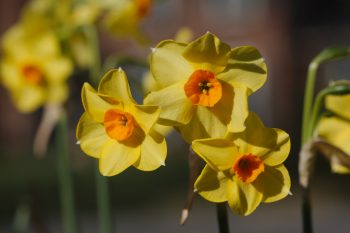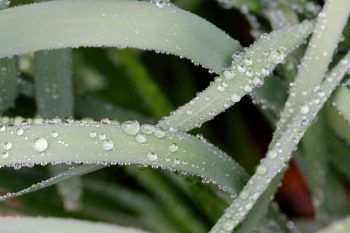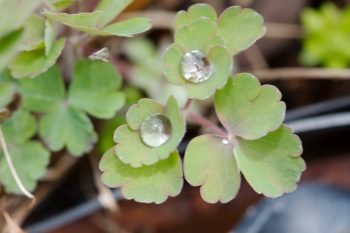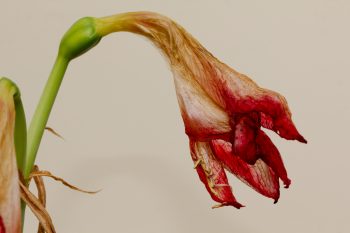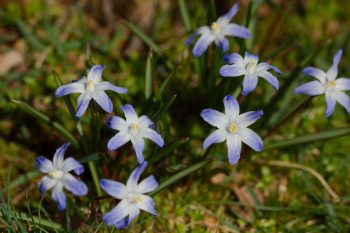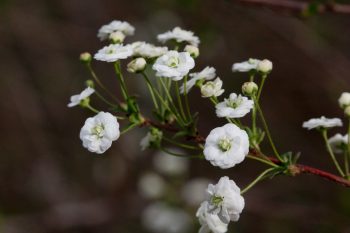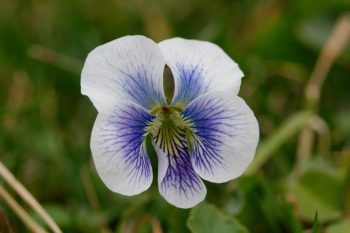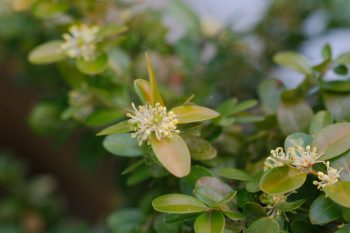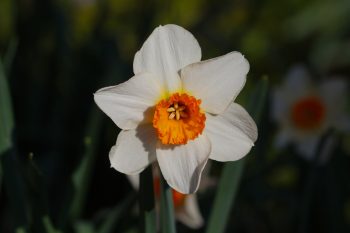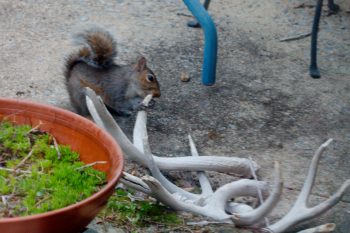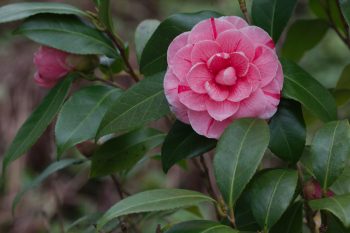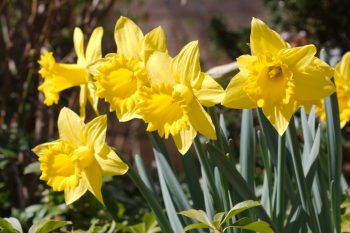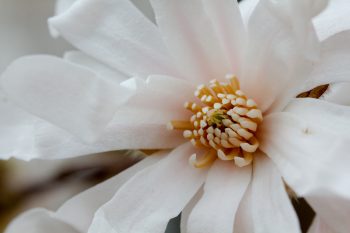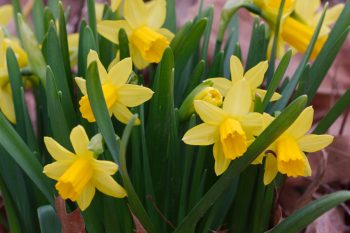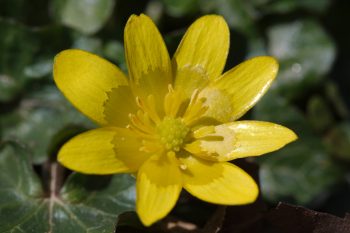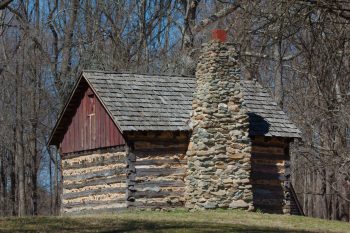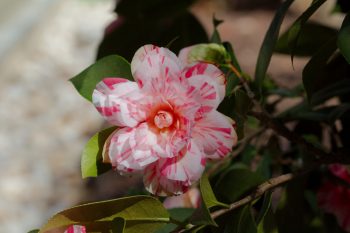One nice thing about being home as we all are is that it means I can get out into the yard during the day. That’s offset by the fact that we can’t go a lot of other places, of course, but we are fortunate to have a pretty nice yard. There’s a huge amount that needs to be done but right now, with the daffodils blooming, it’s quite nice. This little daffodil, one of the Tazetta types, has multiple fragrant flowers on each stem. They were planted in 2014 and are on the edge of the bed that used to surround the spruce tree, which is gone, so they will get a lot more sun now.
Daffodil ‘Falconet’
Daffodil Leaves In The Rain
It rained again today and I spent most of the day indoors, working. We’re into our second week of the great coronavirus hunker of 2020 and it’s been a mixed bag. On the one hand, when the weather has been nice, which has been most days, it’s been great to get out into the yard. That’s nicer than just going out into the parking lot at work. But when it’s cool and dreary, and I’ve stayed indoors, it’s gotten a bit old, sitting at my computer. It’s nice to be able to do that in an armchair with the computer on my lap, but it’s still work and I much prefer to be able to go outside.
Columbine Leaves
It’s been really nice weather lately, which is great. Since we’re staying around the house, it’s been good to get outdoors, even if only into the yard. We say hello to all the neighborhood walkers, of which there are quite a lot. Today was a bit dreary by comparison so we spent most of the day indoors. I did get out a bit and took a few pictures of things in front of the house, including this columbine leaf with two large water droplets.
Dried Amaryllis Flower
This is the same amaryllis flower that I posted a photo of a week an a half ago (see Thursday, March 12, 2020). As you can see, it’s dried out but interestingly has retained some of it’s color. Since taking this photo, I’ve cut the stem so we won’t get any seeds. They are so easily available in bulb form late in the year that we buy one most years. This one came back into bloom, a little later than expected but without much of any attention having been paid to it in the meantime.
Chionodoxa forbesii
I think this is my absolute favorite of the spring ephemerals. It’s called glory of the snow in honor of it’s generally very early blooming time, sometimes when there is still snow on the ground. The genus Chionodoxa comes from the Greek words chion meaning snow and doxa meaning glory. I think it’s the color that I like best about it, along with its dainty habit and it’s remarkably easy care. It is hardy as far north as USDA zone 3. In a few short weeks it will be done and gone for the year, sleeping away both the heat of summer and the cold of next winter.
Spiraea prunifolia
Our spiraea is in bloom and it’s really pretty as a background plant. It’s flowers are small but borne in a profusion of white. There are little bits of green in the flowers, but that can really only be seen close up. Spiraea prunifolia, bridal wreath spiraea, is a native of China, Japan, Korea, and Taiwan and has been introduced in much of eastern North America. Interestingly, this double-flowered plant has the species name while the single-flowered variety, discovered later, is classified as a variety or form of the species. The name of the genus Spiraea comes from the Greek word speira meaning wreath.
Wild Violet
The wild violets (Viola sororia) are up in the lawn. They’re pretty difficult to get rid of but our lawn is not particularly weed free in general, so they are among the least of our worries. The flowers range in color from nearly all white to nearly all bluish purple. This one is about half way in between. We actually have a few yellow violets and I’m assuming those are a different species, possibly Viola pubescens, but I don’t actually know that. They look very similar to these, except for the flower color.
Box Flowers
There were a few mid-sized box shrubs along our front walk when we bought the house in 2006. Between a few heavy snowfalls breaking some of their stems and a particularly dry summer one year, they have died back to one main stem. It’s doing fine although it looks a little sad, with the rest of the bush gone. There is another, much larger box at the corner of the garage and it made it through the same years with little or no apparent damage. They are in bloom right now, although as you can see, no one is likely to grow box for their flowers.
Daffodil
This is one of my unknown daffodils. The fall when we moved into our house I took some family pictures for some friends and they gave me a bunch of bulbs as a thank you present. They either were not marked or, more likely, I didn’t write down the names, but they bloom every year. This is one of them. There is another, very double daffodil as well and the hyacinths that I posted a picture of a couple days ago. The daffodils are between our front walk and the house and put on a really good show.
Squirrel Chewing on Antlers
We have some antlers, collected over the years. A few of them Dorothy had hanging in her room for a while. Other have been out back on the side of the patio, along with some sea shells. We also have a beaver skull that showed up in our yard a while back. We have no idea where it came from, as it was very clean and dry, although relatively full and intact otherwise. This morning Cathy looked out the kitchen door and saw this squirrel chewing on the antlers. They’re a good source of calcium and that’s where they generally go in the wild as part of the cycle of life. It’s not the sharpest photo you’ll ever see, having been taken at a sharp angle through the regular glass of the kitchen door.
Pink Hyacinths
The hyacinths are in bloom. These were planted pretty soon after we moved in and they didn’t really thrive but every year they come up. There are three little clumps of them, one purple, one white, and this pink one. They are growing in a bed of Vinca minor, also known as periwinkle, and lily of the valley (Convallaria majalis). You can see a little of the periwinkle color in the background. It’s nice to see them out our kitchen door. I’m not a fan of their fragrance, so I like they more at a distance than close up.
Camellia ‘Dad’s Pink’
I currently have three camellia plants in the yard. This one it the largest and has the most flowers. It’s called ‘Dad’s Pink’ and though it isn’t a variety that my dad grew, it reminds me of him. I also have ‘Pink Perfection’, which he did have. That one ws quite small when I got it and has taken a little while to get established but it looks like it’s doing pretty well finally (and after I lowered the pH around it a bit). The third is called ‘Mrs. Lyman Clarke’ and dad had that one, as well, out back beside the chimney. It’s barely alive and only time will tell if it’s going to survive. It has six leaves and one flower bud.
Daffodil ‘Arkle’
As mentioned yesterday, the daffodils are really starting to come out in great numbers. This is one called ‘Arkle’ and it’s a big, bold, beautiful yellow flowered variety. I planted these back in 2014 and they are very well established. Daffodils are long lived and form nice clumps. Where you put one bulb, you will eventually have a group of them, each putting up flowers, so the longer they are in the ground, the better. Others that were planted more recently, a variety called ‘Marieke’ that has similar but slightly larger flowers is still putting up only 3 or 4 blooms per clump. But they should continue to get better each year.
Star Magnolia
The star magnolia (Magnolia stellata) is a really nice flowering tree, relatively slow growing but eventually getting up to about 20 feet tall and nearly as wide. It flowers rather early in the spring and it’s not uncommon, at least here, for the blooms to be killed by a late frost. We’ve been spared that this year and they are blooming all over right now. The generally later saucer magnolia (Magnolia × soulangeana) is starting to bloom around the neighborhood, also. There are some cherries blooming and the daffodils are coming out in great numbers. It’s a pretty time of year.
Amaryllis
We have two amaryllis bulbs from last year that we pretty much neglected after they finished blooming. They had leaves for a while but we stopped watering them and they just sat on shelves in the kitchen after that. They normally bloom around Christmas time, which is lovely, of course, but we weren’t paying them any attention. A week ago I notice this one had sent up a shoot with a bud on top so it got a little water. It has rewarded our neglect with two lovely blooms. It now has a spot on the kitchen counter. I had to add two stakes to hold it up because the flowers are pretty heavy and the pot it’s in is not.
‘Tete-A-Tete’ Daffodils
Daffodils are starting to bloom all over. The early varieties, particularly in warm locations, have been in bloom for a week or so. These are our first to get fully out. They are called ‘Tete-A-Tete’ and they are a nice, little, clump-forming variety that I really like. We have them in a few places and they are very happy, blooming as the others are still forming buds. They are only about 8 to 10 inches tall, so not suited for growing in with too much ground cover. So, in the pachysandra we have taller varieties, like ‘Arkle’ which is big and bold but blooms a little later.
Goose Feather
Spring really feels like it’s here. The first half of March is too early to be too sure we’re completely done with winter and we’ve had big snow storms later than this, but it’s really feeling like spring this week and I think a lot of folks are hoping it’s for real. The pears are starting to bloom and I’ve seen cherries and magnolias in bloom. I went out early this afternoon and wandered around a bit looking for things to photograph and came across this feather, probably a Canada goose feather, down by a drainage pond near my building.
Ficaria verna
This is Ficaria verna, formerly known as Ranunculus ficaria, commonly called the fig buttercup or lesser celandine. It is a weed and is listed as a noxious weed by a bunch of states and banned in at least two. It’s growing wild in the area around the pond next to my building. I’ve had enough experience with invasive weeds that I understand the desire to keep them out so I wouldn’t ever plant this. Nevertheless, I can appreciate the beautiful, bright yellow flowers. It is a tuberous rooted, herbaceous perennial native to western and central Asia and Europe. After flowering, the leaves die back by early summer and the plant goes dormant until the next spring.
Log Cabin
It was such a beautiful day that after church we decided to stop at Meadowside Nature Center and take a walk. Shortly after we parked we heard a hawk call out and saw it land in a tree overhead. I was able to get a few photos of it—either a Cooper’s or sharp-shinned—but they were from such a low angle they aren’t really all that good. We continued down past the pond to the Pioneer Homestead, where this photo was taken. There are two log cabins, a smoke house, and a corn crib. From there we walked down to Lake Frank and saw one of the eagles on their nest, which was cool. All in all, a very nice outing.
Camellia japonica
I went over to my mom’s this morning to see her and to do a few things around her apartment. After the minor chores, we took a walk around the loop she walks most days, about a third of a mile. We started by taking a slight detour to see the two Camellia japonica bushes that are in bloom outside the enclosed walkway just past the dining hall. They are absolutely covered with pink and white flowers, both varying somewhat from almost all pink to mostly white with pink lines. I have three plants in my yard, all small (and one is very small). One of them has buds but none are blooming yet. Looking forward to that.

